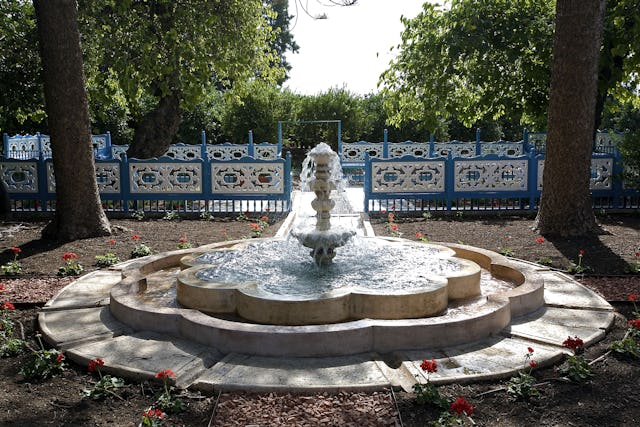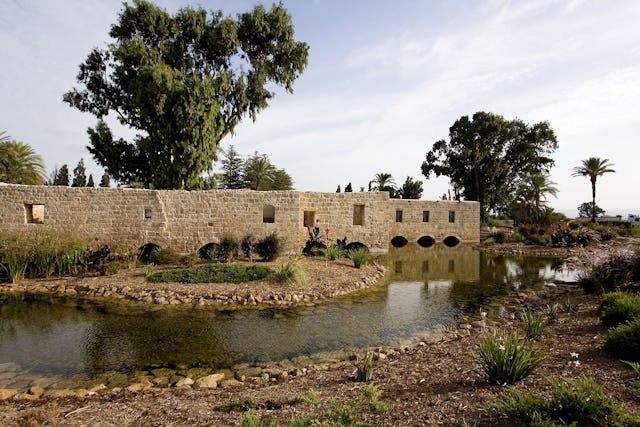Holy place restoration sheds light on region's heritage
ACRE, Israel — After more than three years of restoration and conservation work, a Baha'i sacred site is offering a glimpse into the industrial and spiritual heritage of this part of the Holy Land.
From the Roman era into the early 20th century, mills on this site – some two kilometers southeast of the old city of Acre – produced the flour to feed the area's population.
"This was a very significant agricultural hinterland for the city," points out Albert Lincoln, Secretary General of the Baha'i International Community. "The mills were part of what was probably one of the region's largest industrial complexes. They were first documented in 1799 by the French delegation surveying the area in connection with Napoleon's intended conquest."
But for Baha'is, this place has spiritual significance, adds Mr. Lincoln. "It's one of the most beautiful holy places associated with the presence of Baha'u'llah here during the late 19th century."
In 1875 – eight years after Baha'u'llah's incarceration within the walls of the prison city of Acre – His son 'Abdul-Baha rented an island formed by two water canals, diverted from the Na'mayn river to power the flour mills. On this island, 'Abdu'l-Baha created an exquisite garden for His father Who, by then, had suffered more than two decades of imprisonment and exile. Baha'u'llah called the garden "Ridvan" – meaning "paradise".
A swamp drainage scheme to curb malaria and increase arable farmland in the 1930s and 1940s deprived the garden of its unique island setting. But now, with the restoration of the water canals, the Ridvan Garden is an island once again. This week, some 280 Baha'is – from as far afield as Mongolia, Rwanda and El Salvador – became the first pilgrims since 2007 to visit this holy place.
A "verdant isle"
After 'Abdu'l-Baha's acquisition of the island, pilgrims from Iran and neighboring countries brought shrubs, trees and flowering plants to populate the flower beds. During their long overland journeys, some of the travelers watered the plants at the expense of their own thirst.
As restrictions on His movements were gradually relaxed, Baha'u'llah made His first visits to the garden. He went there often, sometimes staying overnight in a modest house on the island.
The spot also became known outside of the Baha'i community. Laurence Oliphant, a British writer who visited in 1883, remarked, "Coming upon it suddenly it is like a scene in fairy land...The stream is fringed with weeping willows, and the spot, with its wealth of water, its thick shade, and air fragrant with jasmine and orange blossoms, forms an ideal retreat from the heats of summer."
Using historic photographs and descriptions, an international team of architects and engineers has restored the Ridvan garden to its original character, assisted by the Israel Antiquity Authority which provided a conservation survey of the entire site and carried out part of the work.
"Our mission was to re-create the island as it had been at the time of Baha'u'llah," says Khosrow Rezai, a representative of the design team who oversaw the project. "So our task was to investigate and find as much historical evidence as we could about how it looked, so we could bring the island back to life."
The two water canals have been reinstated on either side of the garden at their original locations, leading to the flour mills – some of which have also been restored. "We found an aquifer 40 meters underground and are using it to feed the canals," says Mr. Rezai. "But the configuration of the canals gives the impression that the water is once again coming from the mountains and is flowing out towards the ocean."
With the re-creation of the garden's original setting, pilgrims can now experience the feeling of a spiritual retreat. "We have tried to convey, to the extent possible, the tranquillity of the garden prepared by 'Abdu'l-Baha as a place where Baha'u'llah could find rest," says Mr. Rezai. "Being able to see the water gives you an amazing feeling. You cross it, you smell it, you hear it. Hopefully it transmits the sense of happiness and joy that Baha'u'llah felt."
Albert Lincoln agrees that the restoration has brought about a radical change in the atmosphere of the place. "It's part of the territory that comes with being a religion born in historical time – as opposed to archaeological time – that we have the possibility of doing authentic restoration and of recreating quite closely the feeling that prevailed when Baha'u'llah was actually here. He referred to it as 'Our Verdant Isle' and wrote some beautiful things in which he describes Himself actually sitting in the garden at the time when it had water around it.
"In one passage, Baha'u'llah says that He was here in the garden enjoying 'its streams flowing, and its trees luxuriant, and the sunlight playing in their midst.' The whole narrative that goes with it is an outdoors narrative – it's sun, wind, water – all these factors," enthuses Mr. Lincoln.
A unique holy place
Just visible on the southern horizon from the site, Mount Carmel rises up, the location of the Shrine of the Bab and its monumental garden terraces. They – along with the Shrine of Baha'u'llah and its environs north of the Ridvan garden – were named UNESCO World Heritage sites in 2008.
But the Ridvan Garden is unique among Baha'i holy places, says Mr. Lincoln. "In the others, the gardens surround buildings and structures. But here, the holy place is in itself a garden, and on a more intimate scale than the others."
"With its conservation – and the restoration of the flour mills – the whole site says something about the historical roots of the Baha'i Faith in this land and how they are intertwined with the history of the country," he says.

